Contemporary Business Economics
VerifiedAdded on 2023/06/15
|13
|3311
|285
AI Summary
This report compares contemporary and traditional economic theories and their relevance to modern business practices. It discusses the differences between modern and traditional theories and their impact on understanding consumer behavior and market dynamics.
Contribute Materials
Your contribution can guide someone’s learning journey. Share your
documents today.
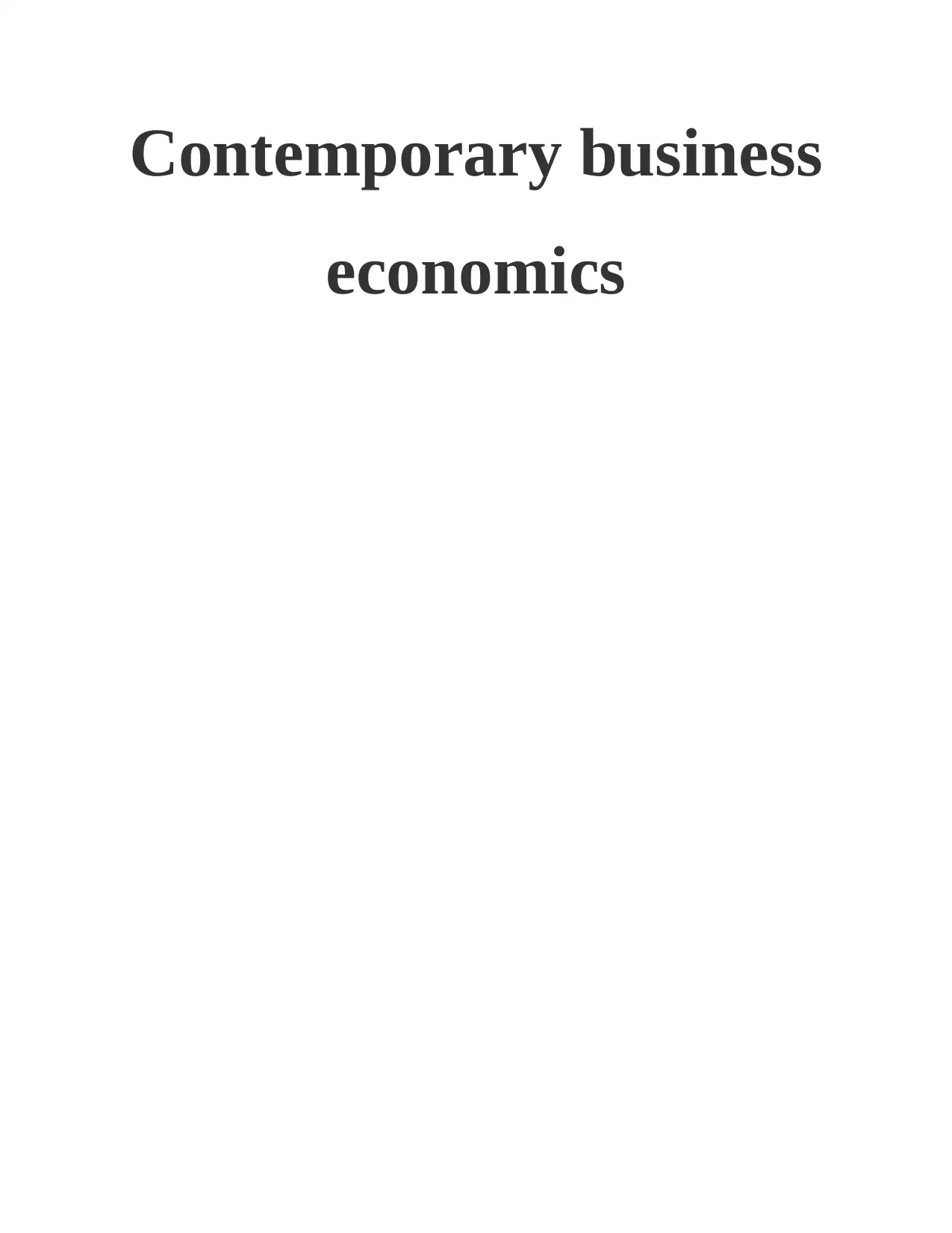
Contemporary business
economics
economics
Secure Best Marks with AI Grader
Need help grading? Try our AI Grader for instant feedback on your assignments.
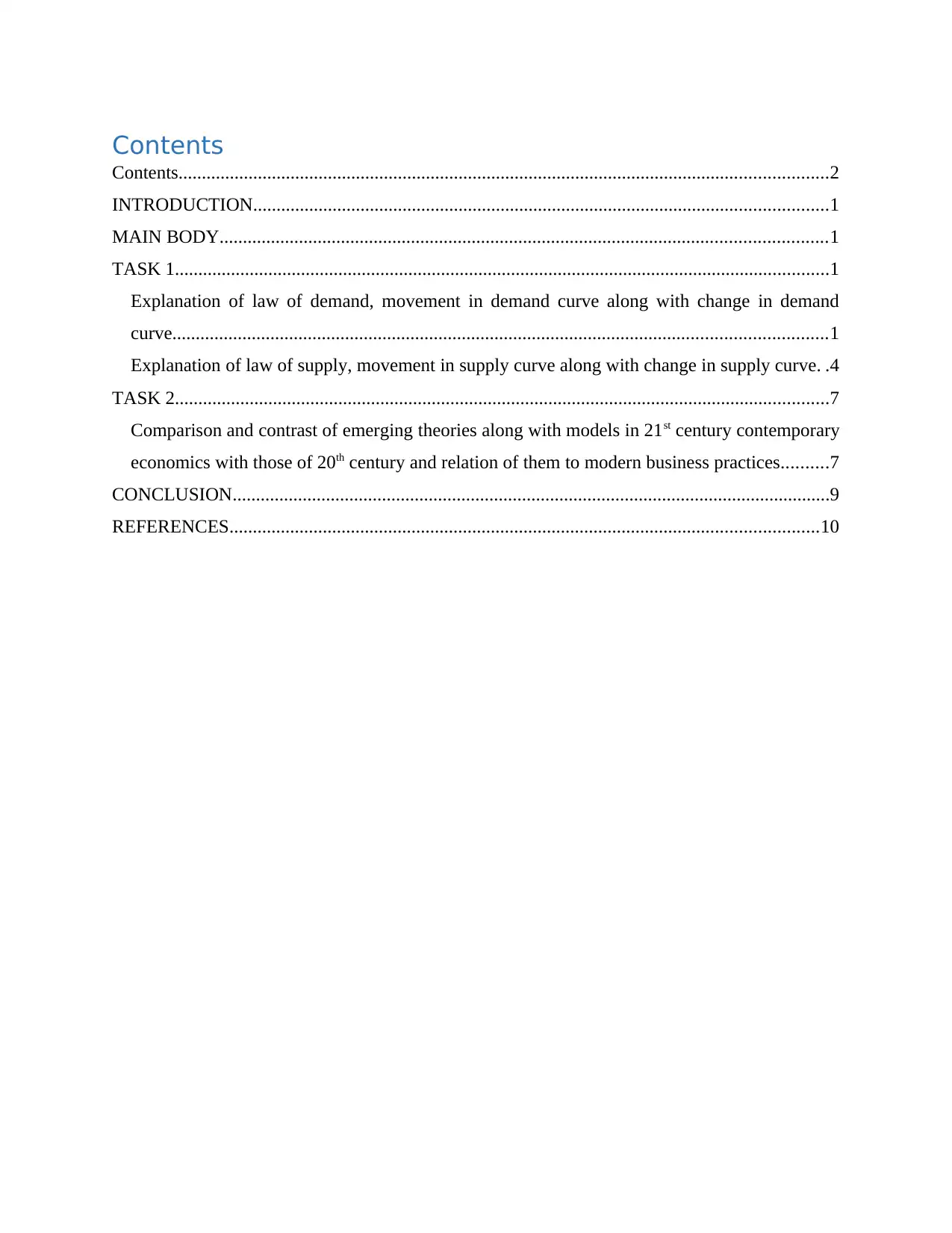
Contents
Contents...........................................................................................................................................2
INTRODUCTION...........................................................................................................................1
MAIN BODY..................................................................................................................................1
TASK 1............................................................................................................................................1
Explanation of law of demand, movement in demand curve along with change in demand
curve............................................................................................................................................1
Explanation of law of supply, movement in supply curve along with change in supply curve. .4
TASK 2............................................................................................................................................7
Comparison and contrast of emerging theories along with models in 21st century contemporary
economics with those of 20th century and relation of them to modern business practices..........7
CONCLUSION................................................................................................................................9
REFERENCES..............................................................................................................................10
Contents...........................................................................................................................................2
INTRODUCTION...........................................................................................................................1
MAIN BODY..................................................................................................................................1
TASK 1............................................................................................................................................1
Explanation of law of demand, movement in demand curve along with change in demand
curve............................................................................................................................................1
Explanation of law of supply, movement in supply curve along with change in supply curve. .4
TASK 2............................................................................................................................................7
Comparison and contrast of emerging theories along with models in 21st century contemporary
economics with those of 20th century and relation of them to modern business practices..........7
CONCLUSION................................................................................................................................9
REFERENCES..............................................................................................................................10
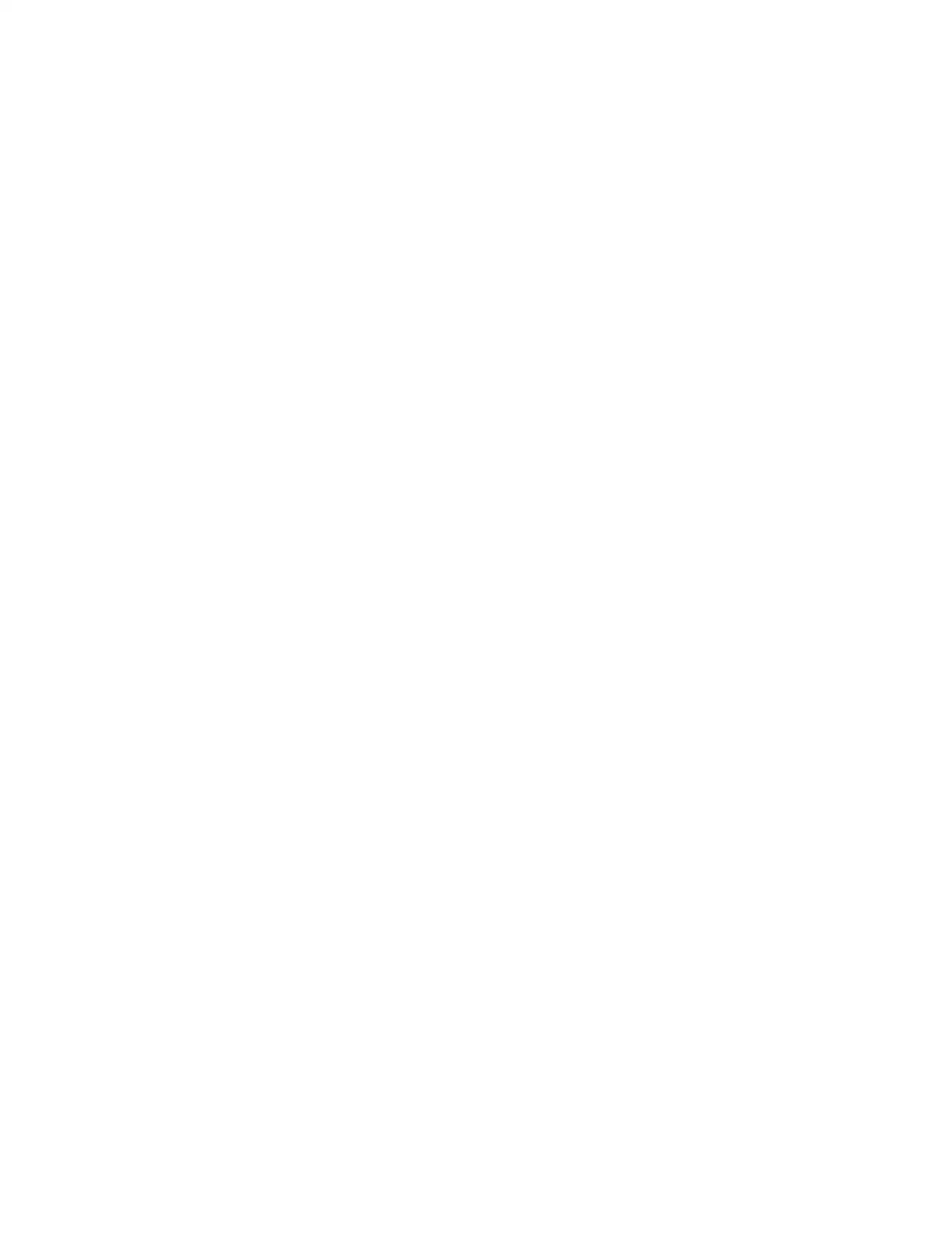
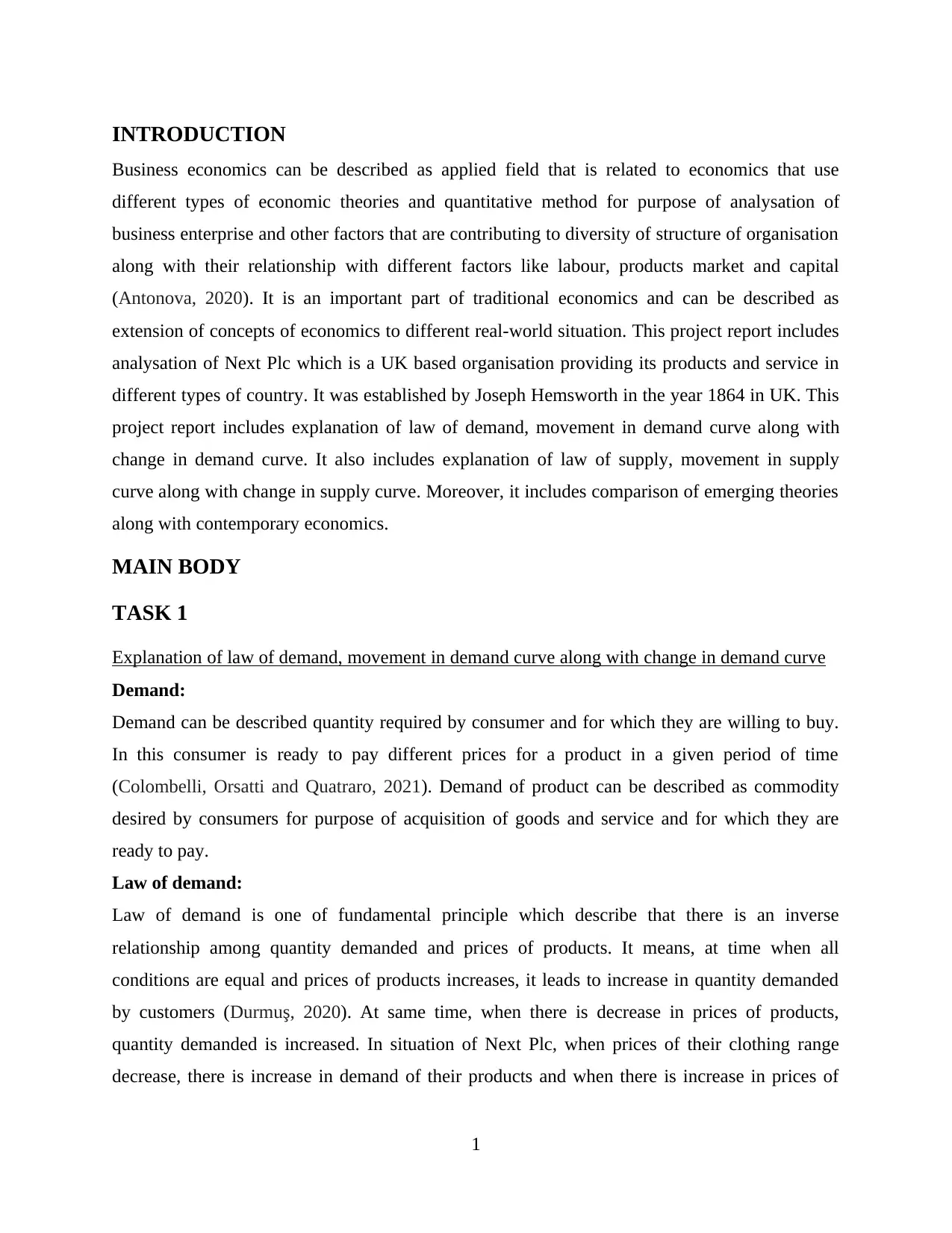
INTRODUCTION
Business economics can be described as applied field that is related to economics that use
different types of economic theories and quantitative method for purpose of analysation of
business enterprise and other factors that are contributing to diversity of structure of organisation
along with their relationship with different factors like labour, products market and capital
(Antonova, 2020). It is an important part of traditional economics and can be described as
extension of concepts of economics to different real-world situation. This project report includes
analysation of Next Plc which is a UK based organisation providing its products and service in
different types of country. It was established by Joseph Hemsworth in the year 1864 in UK. This
project report includes explanation of law of demand, movement in demand curve along with
change in demand curve. It also includes explanation of law of supply, movement in supply
curve along with change in supply curve. Moreover, it includes comparison of emerging theories
along with contemporary economics.
MAIN BODY
TASK 1
Explanation of law of demand, movement in demand curve along with change in demand curve
Demand:
Demand can be described quantity required by consumer and for which they are willing to buy.
In this consumer is ready to pay different prices for a product in a given period of time
(Colombelli, Orsatti and Quatraro, 2021). Demand of product can be described as commodity
desired by consumers for purpose of acquisition of goods and service and for which they are
ready to pay.
Law of demand:
Law of demand is one of fundamental principle which describe that there is an inverse
relationship among quantity demanded and prices of products. It means, at time when all
conditions are equal and prices of products increases, it leads to increase in quantity demanded
by customers (Durmuş, 2020). At same time, when there is decrease in prices of products,
quantity demanded is increased. In situation of Next Plc, when prices of their clothing range
decrease, there is increase in demand of their products and when there is increase in prices of
1
Business economics can be described as applied field that is related to economics that use
different types of economic theories and quantitative method for purpose of analysation of
business enterprise and other factors that are contributing to diversity of structure of organisation
along with their relationship with different factors like labour, products market and capital
(Antonova, 2020). It is an important part of traditional economics and can be described as
extension of concepts of economics to different real-world situation. This project report includes
analysation of Next Plc which is a UK based organisation providing its products and service in
different types of country. It was established by Joseph Hemsworth in the year 1864 in UK. This
project report includes explanation of law of demand, movement in demand curve along with
change in demand curve. It also includes explanation of law of supply, movement in supply
curve along with change in supply curve. Moreover, it includes comparison of emerging theories
along with contemporary economics.
MAIN BODY
TASK 1
Explanation of law of demand, movement in demand curve along with change in demand curve
Demand:
Demand can be described quantity required by consumer and for which they are willing to buy.
In this consumer is ready to pay different prices for a product in a given period of time
(Colombelli, Orsatti and Quatraro, 2021). Demand of product can be described as commodity
desired by consumers for purpose of acquisition of goods and service and for which they are
ready to pay.
Law of demand:
Law of demand is one of fundamental principle which describe that there is an inverse
relationship among quantity demanded and prices of products. It means, at time when all
conditions are equal and prices of products increases, it leads to increase in quantity demanded
by customers (Durmuş, 2020). At same time, when there is decrease in prices of products,
quantity demanded is increased. In situation of Next Plc, when prices of their clothing range
decrease, there is increase in demand of their products and when there is increase in prices of
1
Secure Best Marks with AI Grader
Need help grading? Try our AI Grader for instant feedback on your assignments.
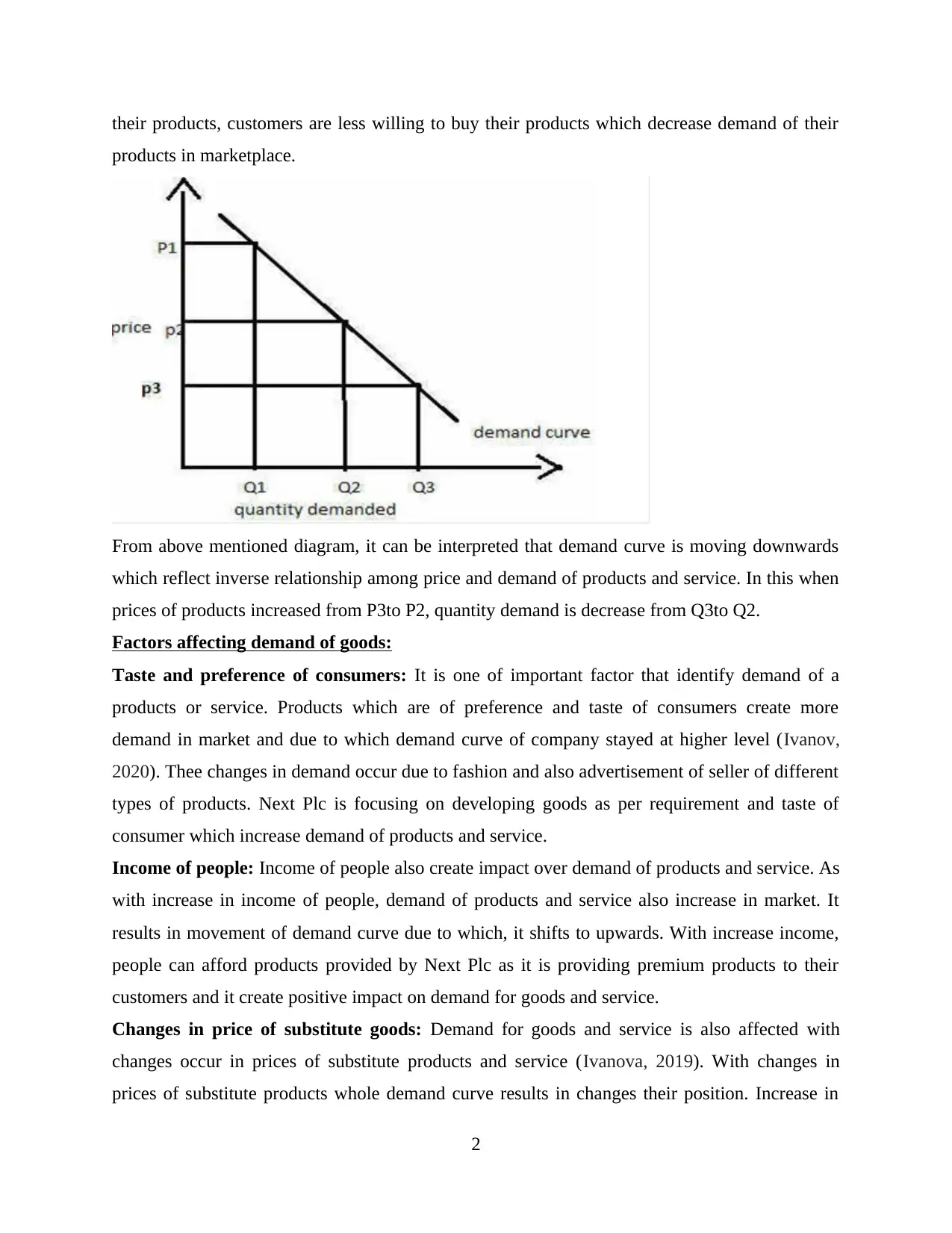
their products, customers are less willing to buy their products which decrease demand of their
products in marketplace.
From above mentioned diagram, it can be interpreted that demand curve is moving downwards
which reflect inverse relationship among price and demand of products and service. In this when
prices of products increased from P3to P2, quantity demand is decrease from Q3to Q2.
Factors affecting demand of goods:
Taste and preference of consumers: It is one of important factor that identify demand of a
products or service. Products which are of preference and taste of consumers create more
demand in market and due to which demand curve of company stayed at higher level (Ivanov,
2020). Thee changes in demand occur due to fashion and also advertisement of seller of different
types of products. Next Plc is focusing on developing goods as per requirement and taste of
consumer which increase demand of products and service.
Income of people: Income of people also create impact over demand of products and service. As
with increase in income of people, demand of products and service also increase in market. It
results in movement of demand curve due to which, it shifts to upwards. With increase income,
people can afford products provided by Next Plc as it is providing premium products to their
customers and it create positive impact on demand for goods and service.
Changes in price of substitute goods: Demand for goods and service is also affected with
changes occur in prices of substitute products and service (Ivanova, 2019). With changes in
prices of substitute products whole demand curve results in changes their position. Increase in
2
products in marketplace.
From above mentioned diagram, it can be interpreted that demand curve is moving downwards
which reflect inverse relationship among price and demand of products and service. In this when
prices of products increased from P3to P2, quantity demand is decrease from Q3to Q2.
Factors affecting demand of goods:
Taste and preference of consumers: It is one of important factor that identify demand of a
products or service. Products which are of preference and taste of consumers create more
demand in market and due to which demand curve of company stayed at higher level (Ivanov,
2020). Thee changes in demand occur due to fashion and also advertisement of seller of different
types of products. Next Plc is focusing on developing goods as per requirement and taste of
consumer which increase demand of products and service.
Income of people: Income of people also create impact over demand of products and service. As
with increase in income of people, demand of products and service also increase in market. It
results in movement of demand curve due to which, it shifts to upwards. With increase income,
people can afford products provided by Next Plc as it is providing premium products to their
customers and it create positive impact on demand for goods and service.
Changes in price of substitute goods: Demand for goods and service is also affected with
changes occur in prices of substitute products and service (Ivanova, 2019). With changes in
prices of substitute products whole demand curve results in changes their position. Increase in
2
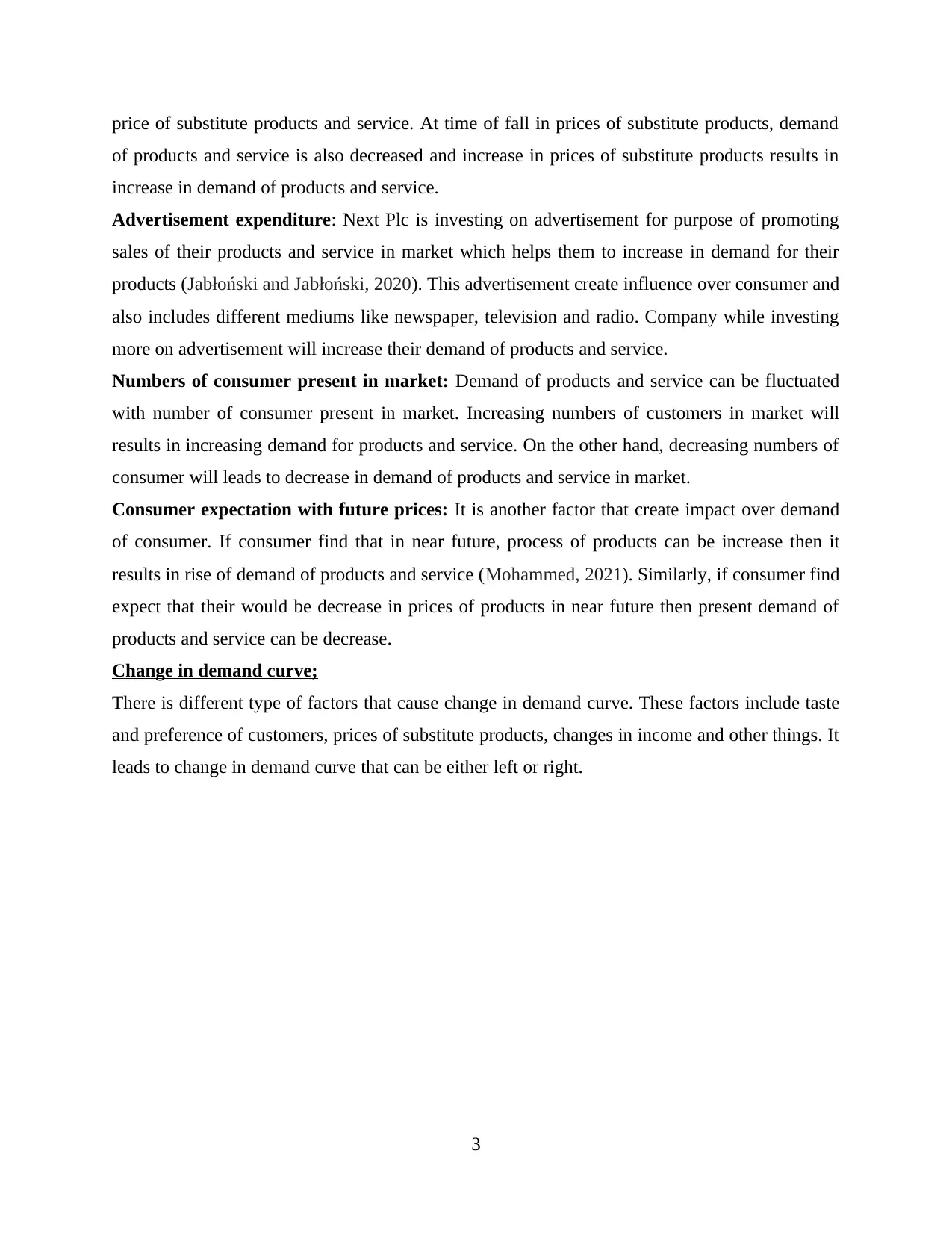
price of substitute products and service. At time of fall in prices of substitute products, demand
of products and service is also decreased and increase in prices of substitute products results in
increase in demand of products and service.
Advertisement expenditure: Next Plc is investing on advertisement for purpose of promoting
sales of their products and service in market which helps them to increase in demand for their
products (Jabłoński and Jabłoński, 2020). This advertisement create influence over consumer and
also includes different mediums like newspaper, television and radio. Company while investing
more on advertisement will increase their demand of products and service.
Numbers of consumer present in market: Demand of products and service can be fluctuated
with number of consumer present in market. Increasing numbers of customers in market will
results in increasing demand for products and service. On the other hand, decreasing numbers of
consumer will leads to decrease in demand of products and service in market.
Consumer expectation with future prices: It is another factor that create impact over demand
of consumer. If consumer find that in near future, process of products can be increase then it
results in rise of demand of products and service (Mohammed, 2021). Similarly, if consumer find
expect that their would be decrease in prices of products in near future then present demand of
products and service can be decrease.
Change in demand curve;
There is different type of factors that cause change in demand curve. These factors include taste
and preference of customers, prices of substitute products, changes in income and other things. It
leads to change in demand curve that can be either left or right.
3
of products and service is also decreased and increase in prices of substitute products results in
increase in demand of products and service.
Advertisement expenditure: Next Plc is investing on advertisement for purpose of promoting
sales of their products and service in market which helps them to increase in demand for their
products (Jabłoński and Jabłoński, 2020). This advertisement create influence over consumer and
also includes different mediums like newspaper, television and radio. Company while investing
more on advertisement will increase their demand of products and service.
Numbers of consumer present in market: Demand of products and service can be fluctuated
with number of consumer present in market. Increasing numbers of customers in market will
results in increasing demand for products and service. On the other hand, decreasing numbers of
consumer will leads to decrease in demand of products and service in market.
Consumer expectation with future prices: It is another factor that create impact over demand
of consumer. If consumer find that in near future, process of products can be increase then it
results in rise of demand of products and service (Mohammed, 2021). Similarly, if consumer find
expect that their would be decrease in prices of products in near future then present demand of
products and service can be decrease.
Change in demand curve;
There is different type of factors that cause change in demand curve. These factors include taste
and preference of customers, prices of substitute products, changes in income and other things. It
leads to change in demand curve that can be either left or right.
3
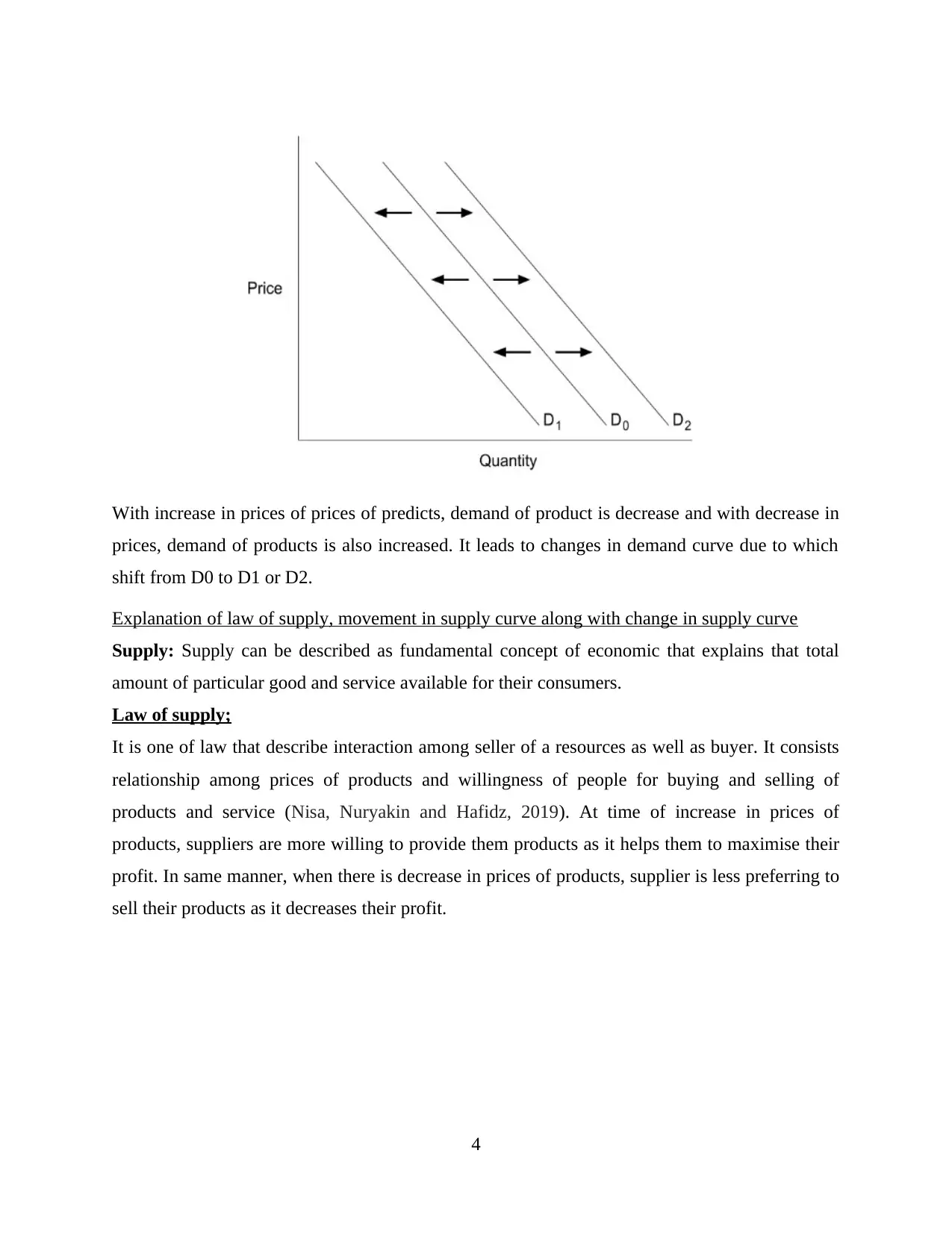
With increase in prices of prices of predicts, demand of product is decrease and with decrease in
prices, demand of products is also increased. It leads to changes in demand curve due to which
shift from D0 to D1 or D2.
Explanation of law of supply, movement in supply curve along with change in supply curve
Supply: Supply can be described as fundamental concept of economic that explains that total
amount of particular good and service available for their consumers.
Law of supply;
It is one of law that describe interaction among seller of a resources as well as buyer. It consists
relationship among prices of products and willingness of people for buying and selling of
products and service (Nisa, Nuryakin and Hafidz, 2019). At time of increase in prices of
products, suppliers are more willing to provide them products as it helps them to maximise their
profit. In same manner, when there is decrease in prices of products, supplier is less preferring to
sell their products as it decreases their profit.
4
prices, demand of products is also increased. It leads to changes in demand curve due to which
shift from D0 to D1 or D2.
Explanation of law of supply, movement in supply curve along with change in supply curve
Supply: Supply can be described as fundamental concept of economic that explains that total
amount of particular good and service available for their consumers.
Law of supply;
It is one of law that describe interaction among seller of a resources as well as buyer. It consists
relationship among prices of products and willingness of people for buying and selling of
products and service (Nisa, Nuryakin and Hafidz, 2019). At time of increase in prices of
products, suppliers are more willing to provide them products as it helps them to maximise their
profit. In same manner, when there is decrease in prices of products, supplier is less preferring to
sell their products as it decreases their profit.
4
Paraphrase This Document
Need a fresh take? Get an instant paraphrase of this document with our AI Paraphraser
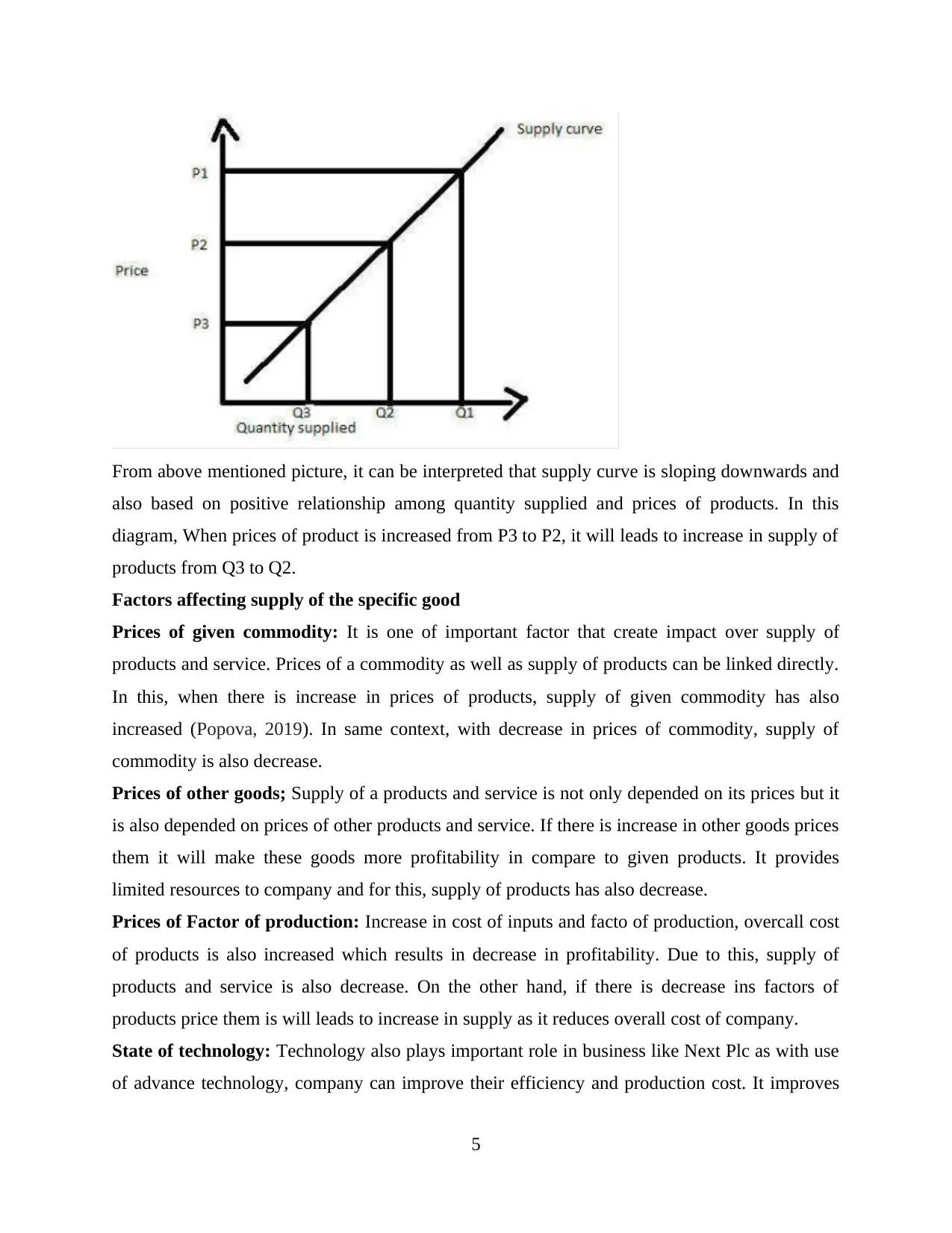
From above mentioned picture, it can be interpreted that supply curve is sloping downwards and
also based on positive relationship among quantity supplied and prices of products. In this
diagram, When prices of product is increased from P3 to P2, it will leads to increase in supply of
products from Q3 to Q2.
Factors affecting supply of the specific good
Prices of given commodity: It is one of important factor that create impact over supply of
products and service. Prices of a commodity as well as supply of products can be linked directly.
In this, when there is increase in prices of products, supply of given commodity has also
increased (Popova, 2019). In same context, with decrease in prices of commodity, supply of
commodity is also decrease.
Prices of other goods; Supply of a products and service is not only depended on its prices but it
is also depended on prices of other products and service. If there is increase in other goods prices
them it will make these goods more profitability in compare to given products. It provides
limited resources to company and for this, supply of products has also decrease.
Prices of Factor of production: Increase in cost of inputs and facto of production, overcall cost
of products is also increased which results in decrease in profitability. Due to this, supply of
products and service is also decrease. On the other hand, if there is decrease ins factors of
products price them is will leads to increase in supply as it reduces overall cost of company.
State of technology: Technology also plays important role in business like Next Plc as with use
of advance technology, company can improve their efficiency and production cost. It improves
5
also based on positive relationship among quantity supplied and prices of products. In this
diagram, When prices of product is increased from P3 to P2, it will leads to increase in supply of
products from Q3 to Q2.
Factors affecting supply of the specific good
Prices of given commodity: It is one of important factor that create impact over supply of
products and service. Prices of a commodity as well as supply of products can be linked directly.
In this, when there is increase in prices of products, supply of given commodity has also
increased (Popova, 2019). In same context, with decrease in prices of commodity, supply of
commodity is also decrease.
Prices of other goods; Supply of a products and service is not only depended on its prices but it
is also depended on prices of other products and service. If there is increase in other goods prices
them it will make these goods more profitability in compare to given products. It provides
limited resources to company and for this, supply of products has also decrease.
Prices of Factor of production: Increase in cost of inputs and facto of production, overcall cost
of products is also increased which results in decrease in profitability. Due to this, supply of
products and service is also decrease. On the other hand, if there is decrease ins factors of
products price them is will leads to increase in supply as it reduces overall cost of company.
State of technology: Technology also plays important role in business like Next Plc as with use
of advance technology, company can improve their efficiency and production cost. It improves
5
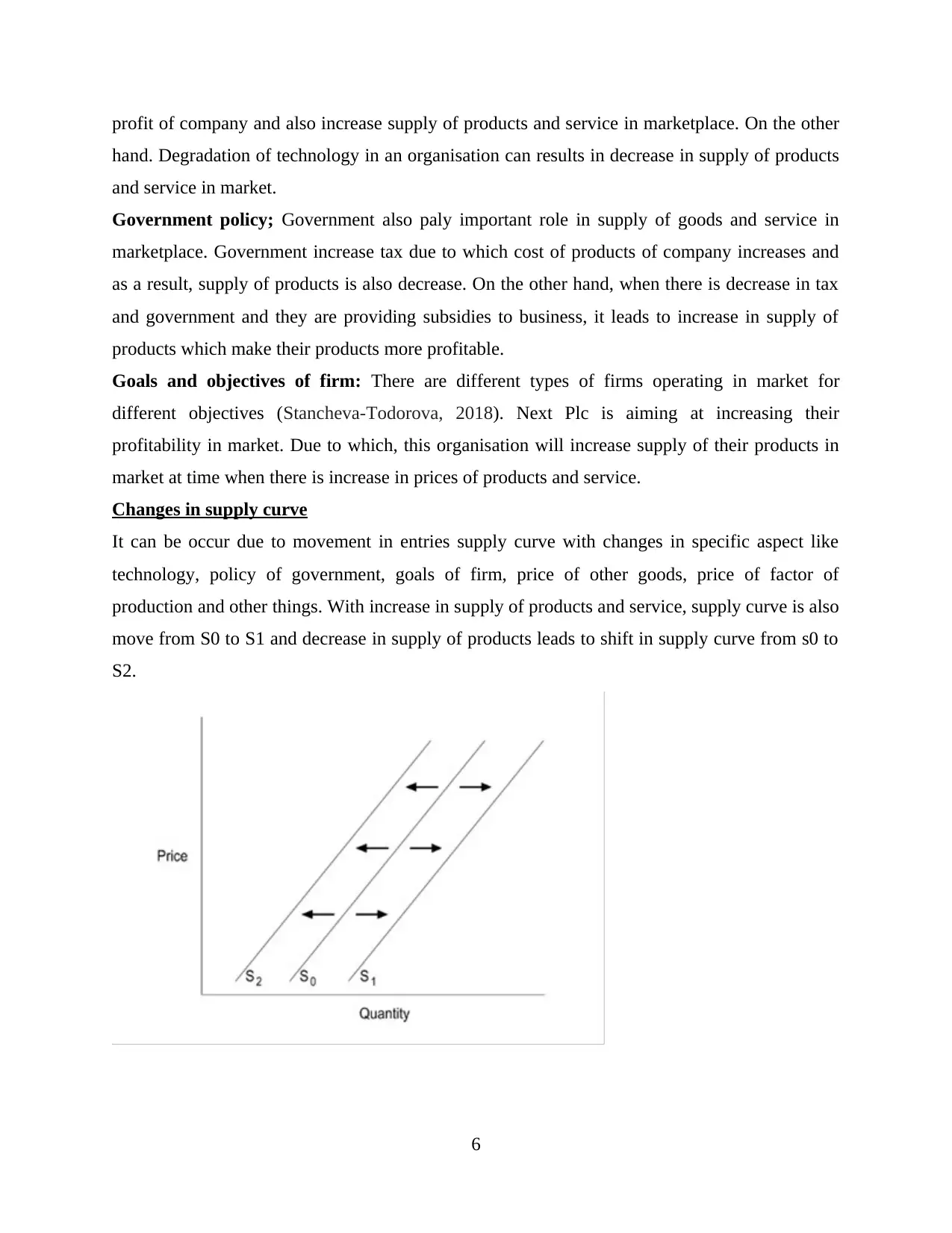
profit of company and also increase supply of products and service in marketplace. On the other
hand. Degradation of technology in an organisation can results in decrease in supply of products
and service in market.
Government policy; Government also paly important role in supply of goods and service in
marketplace. Government increase tax due to which cost of products of company increases and
as a result, supply of products is also decrease. On the other hand, when there is decrease in tax
and government and they are providing subsidies to business, it leads to increase in supply of
products which make their products more profitable.
Goals and objectives of firm: There are different types of firms operating in market for
different objectives (Stancheva-Todorova, 2018). Next Plc is aiming at increasing their
profitability in market. Due to which, this organisation will increase supply of their products in
market at time when there is increase in prices of products and service.
Changes in supply curve
It can be occur due to movement in entries supply curve with changes in specific aspect like
technology, policy of government, goals of firm, price of other goods, price of factor of
production and other things. With increase in supply of products and service, supply curve is also
move from S0 to S1 and decrease in supply of products leads to shift in supply curve from s0 to
S2.
6
hand. Degradation of technology in an organisation can results in decrease in supply of products
and service in market.
Government policy; Government also paly important role in supply of goods and service in
marketplace. Government increase tax due to which cost of products of company increases and
as a result, supply of products is also decrease. On the other hand, when there is decrease in tax
and government and they are providing subsidies to business, it leads to increase in supply of
products which make their products more profitable.
Goals and objectives of firm: There are different types of firms operating in market for
different objectives (Stancheva-Todorova, 2018). Next Plc is aiming at increasing their
profitability in market. Due to which, this organisation will increase supply of their products in
market at time when there is increase in prices of products and service.
Changes in supply curve
It can be occur due to movement in entries supply curve with changes in specific aspect like
technology, policy of government, goals of firm, price of other goods, price of factor of
production and other things. With increase in supply of products and service, supply curve is also
move from S0 to S1 and decrease in supply of products leads to shift in supply curve from s0 to
S2.
6
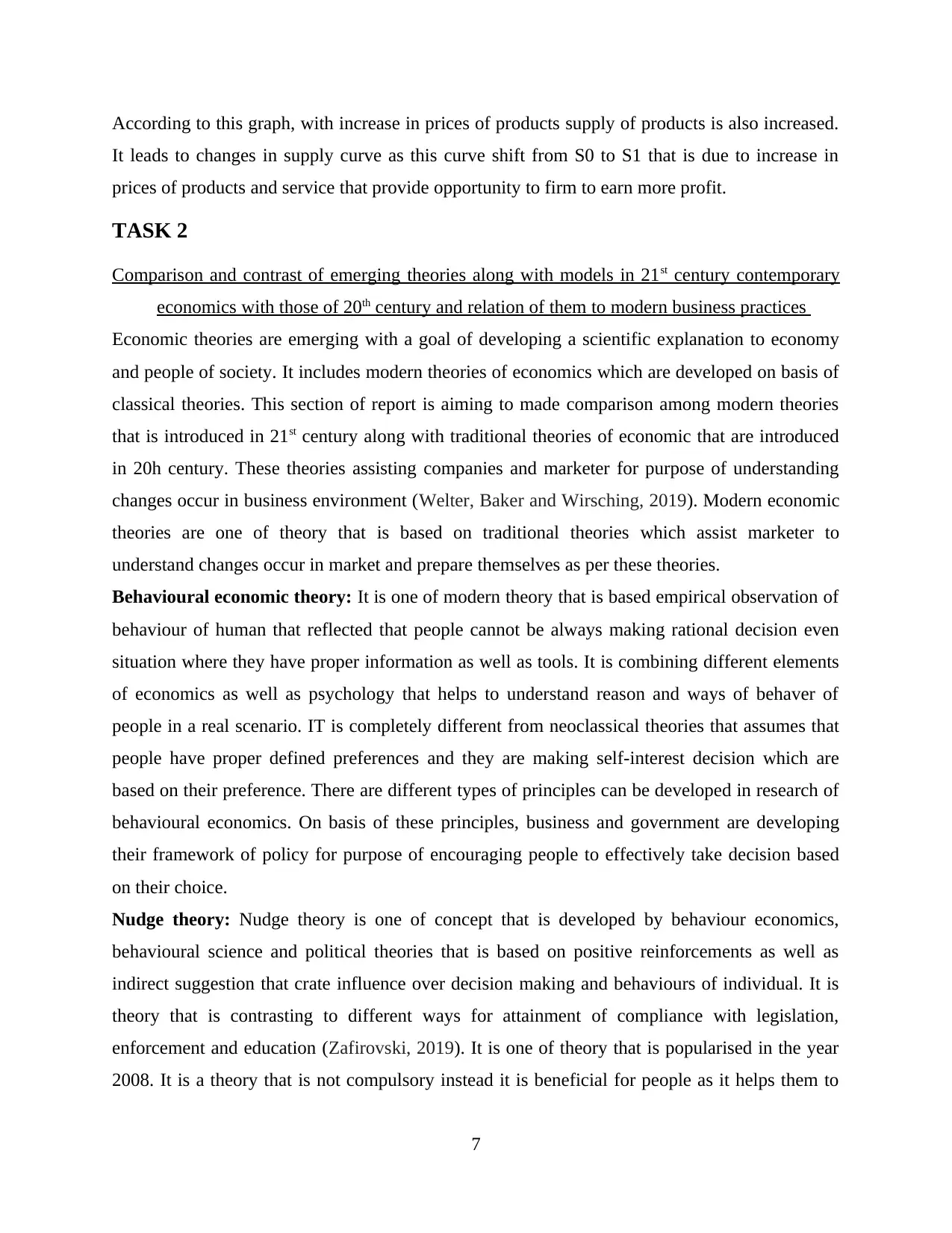
According to this graph, with increase in prices of products supply of products is also increased.
It leads to changes in supply curve as this curve shift from S0 to S1 that is due to increase in
prices of products and service that provide opportunity to firm to earn more profit.
TASK 2
Comparison and contrast of emerging theories along with models in 21st century contemporary
economics with those of 20th century and relation of them to modern business practices
Economic theories are emerging with a goal of developing a scientific explanation to economy
and people of society. It includes modern theories of economics which are developed on basis of
classical theories. This section of report is aiming to made comparison among modern theories
that is introduced in 21st century along with traditional theories of economic that are introduced
in 20h century. These theories assisting companies and marketer for purpose of understanding
changes occur in business environment (Welter, Baker and Wirsching, 2019). Modern economic
theories are one of theory that is based on traditional theories which assist marketer to
understand changes occur in market and prepare themselves as per these theories.
Behavioural economic theory: It is one of modern theory that is based empirical observation of
behaviour of human that reflected that people cannot be always making rational decision even
situation where they have proper information as well as tools. It is combining different elements
of economics as well as psychology that helps to understand reason and ways of behaver of
people in a real scenario. IT is completely different from neoclassical theories that assumes that
people have proper defined preferences and they are making self-interest decision which are
based on their preference. There are different types of principles can be developed in research of
behavioural economics. On basis of these principles, business and government are developing
their framework of policy for purpose of encouraging people to effectively take decision based
on their choice.
Nudge theory: Nudge theory is one of concept that is developed by behaviour economics,
behavioural science and political theories that is based on positive reinforcements as well as
indirect suggestion that crate influence over decision making and behaviours of individual. It is
theory that is contrasting to different ways for attainment of compliance with legislation,
enforcement and education (Zafirovski, 2019). It is one of theory that is popularised in the year
2008. It is a theory that is not compulsory instead it is beneficial for people as it helps them to
7
It leads to changes in supply curve as this curve shift from S0 to S1 that is due to increase in
prices of products and service that provide opportunity to firm to earn more profit.
TASK 2
Comparison and contrast of emerging theories along with models in 21st century contemporary
economics with those of 20th century and relation of them to modern business practices
Economic theories are emerging with a goal of developing a scientific explanation to economy
and people of society. It includes modern theories of economics which are developed on basis of
classical theories. This section of report is aiming to made comparison among modern theories
that is introduced in 21st century along with traditional theories of economic that are introduced
in 20h century. These theories assisting companies and marketer for purpose of understanding
changes occur in business environment (Welter, Baker and Wirsching, 2019). Modern economic
theories are one of theory that is based on traditional theories which assist marketer to
understand changes occur in market and prepare themselves as per these theories.
Behavioural economic theory: It is one of modern theory that is based empirical observation of
behaviour of human that reflected that people cannot be always making rational decision even
situation where they have proper information as well as tools. It is combining different elements
of economics as well as psychology that helps to understand reason and ways of behaver of
people in a real scenario. IT is completely different from neoclassical theories that assumes that
people have proper defined preferences and they are making self-interest decision which are
based on their preference. There are different types of principles can be developed in research of
behavioural economics. On basis of these principles, business and government are developing
their framework of policy for purpose of encouraging people to effectively take decision based
on their choice.
Nudge theory: Nudge theory is one of concept that is developed by behaviour economics,
behavioural science and political theories that is based on positive reinforcements as well as
indirect suggestion that crate influence over decision making and behaviours of individual. It is
theory that is contrasting to different ways for attainment of compliance with legislation,
enforcement and education (Zafirovski, 2019). It is one of theory that is popularised in the year
2008. It is a theory that is not compulsory instead it is beneficial for people as it helps them to
7
Secure Best Marks with AI Grader
Need help grading? Try our AI Grader for instant feedback on your assignments.
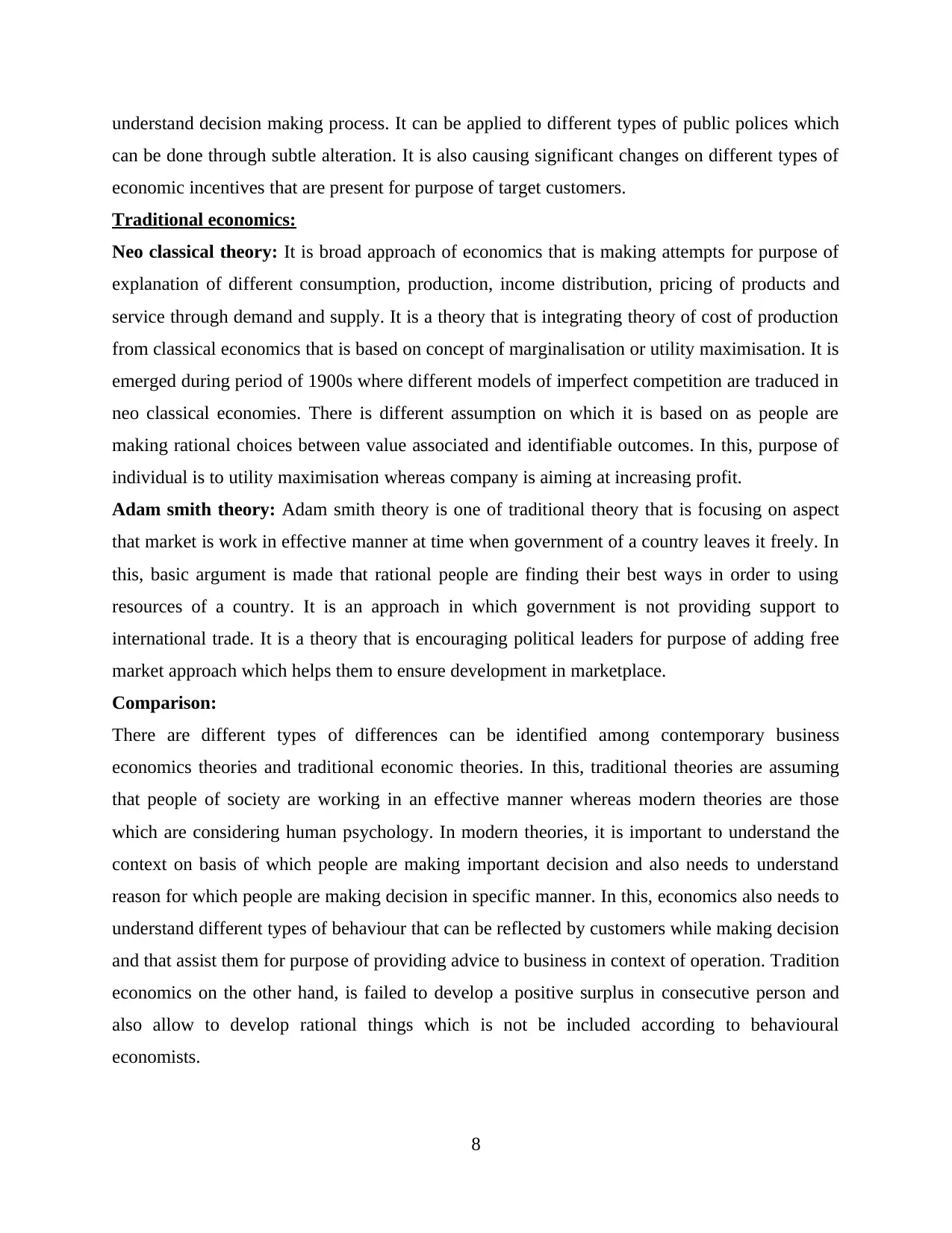
understand decision making process. It can be applied to different types of public polices which
can be done through subtle alteration. It is also causing significant changes on different types of
economic incentives that are present for purpose of target customers.
Traditional economics:
Neo classical theory: It is broad approach of economics that is making attempts for purpose of
explanation of different consumption, production, income distribution, pricing of products and
service through demand and supply. It is a theory that is integrating theory of cost of production
from classical economics that is based on concept of marginalisation or utility maximisation. It is
emerged during period of 1900s where different models of imperfect competition are traduced in
neo classical economies. There is different assumption on which it is based on as people are
making rational choices between value associated and identifiable outcomes. In this, purpose of
individual is to utility maximisation whereas company is aiming at increasing profit.
Adam smith theory: Adam smith theory is one of traditional theory that is focusing on aspect
that market is work in effective manner at time when government of a country leaves it freely. In
this, basic argument is made that rational people are finding their best ways in order to using
resources of a country. It is an approach in which government is not providing support to
international trade. It is a theory that is encouraging political leaders for purpose of adding free
market approach which helps them to ensure development in marketplace.
Comparison:
There are different types of differences can be identified among contemporary business
economics theories and traditional economic theories. In this, traditional theories are assuming
that people of society are working in an effective manner whereas modern theories are those
which are considering human psychology. In modern theories, it is important to understand the
context on basis of which people are making important decision and also needs to understand
reason for which people are making decision in specific manner. In this, economics also needs to
understand different types of behaviour that can be reflected by customers while making decision
and that assist them for purpose of providing advice to business in context of operation. Tradition
economics on the other hand, is failed to develop a positive surplus in consecutive person and
also allow to develop rational things which is not be included according to behavioural
economists.
8
can be done through subtle alteration. It is also causing significant changes on different types of
economic incentives that are present for purpose of target customers.
Traditional economics:
Neo classical theory: It is broad approach of economics that is making attempts for purpose of
explanation of different consumption, production, income distribution, pricing of products and
service through demand and supply. It is a theory that is integrating theory of cost of production
from classical economics that is based on concept of marginalisation or utility maximisation. It is
emerged during period of 1900s where different models of imperfect competition are traduced in
neo classical economies. There is different assumption on which it is based on as people are
making rational choices between value associated and identifiable outcomes. In this, purpose of
individual is to utility maximisation whereas company is aiming at increasing profit.
Adam smith theory: Adam smith theory is one of traditional theory that is focusing on aspect
that market is work in effective manner at time when government of a country leaves it freely. In
this, basic argument is made that rational people are finding their best ways in order to using
resources of a country. It is an approach in which government is not providing support to
international trade. It is a theory that is encouraging political leaders for purpose of adding free
market approach which helps them to ensure development in marketplace.
Comparison:
There are different types of differences can be identified among contemporary business
economics theories and traditional economic theories. In this, traditional theories are assuming
that people of society are working in an effective manner whereas modern theories are those
which are considering human psychology. In modern theories, it is important to understand the
context on basis of which people are making important decision and also needs to understand
reason for which people are making decision in specific manner. In this, economics also needs to
understand different types of behaviour that can be reflected by customers while making decision
and that assist them for purpose of providing advice to business in context of operation. Tradition
economics on the other hand, is failed to develop a positive surplus in consecutive person and
also allow to develop rational things which is not be included according to behavioural
economists.
8
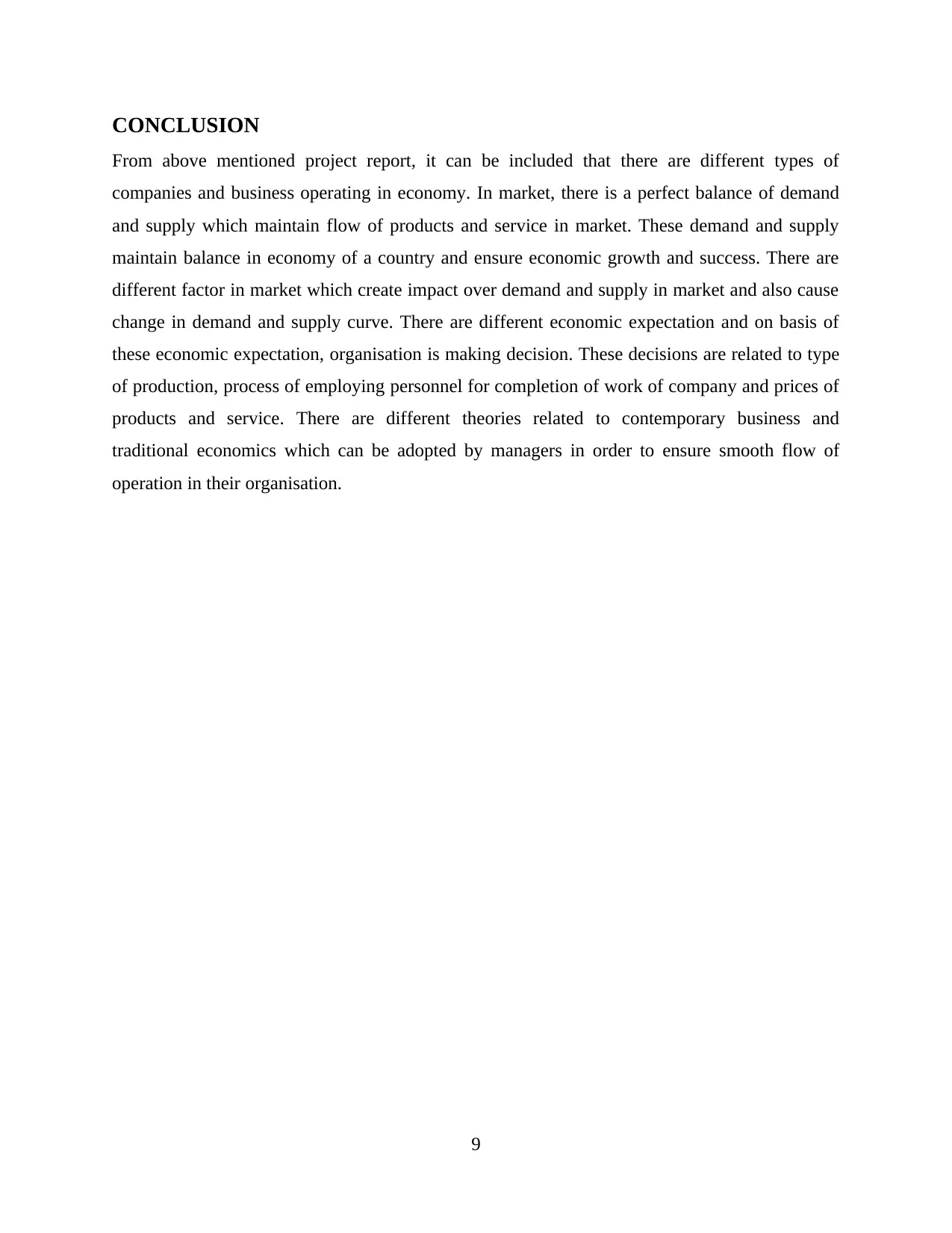
CONCLUSION
From above mentioned project report, it can be included that there are different types of
companies and business operating in economy. In market, there is a perfect balance of demand
and supply which maintain flow of products and service in market. These demand and supply
maintain balance in economy of a country and ensure economic growth and success. There are
different factor in market which create impact over demand and supply in market and also cause
change in demand and supply curve. There are different economic expectation and on basis of
these economic expectation, organisation is making decision. These decisions are related to type
of production, process of employing personnel for completion of work of company and prices of
products and service. There are different theories related to contemporary business and
traditional economics which can be adopted by managers in order to ensure smooth flow of
operation in their organisation.
9
From above mentioned project report, it can be included that there are different types of
companies and business operating in economy. In market, there is a perfect balance of demand
and supply which maintain flow of products and service in market. These demand and supply
maintain balance in economy of a country and ensure economic growth and success. There are
different factor in market which create impact over demand and supply in market and also cause
change in demand and supply curve. There are different economic expectation and on basis of
these economic expectation, organisation is making decision. These decisions are related to type
of production, process of employing personnel for completion of work of company and prices of
products and service. There are different theories related to contemporary business and
traditional economics which can be adopted by managers in order to ensure smooth flow of
operation in their organisation.
9
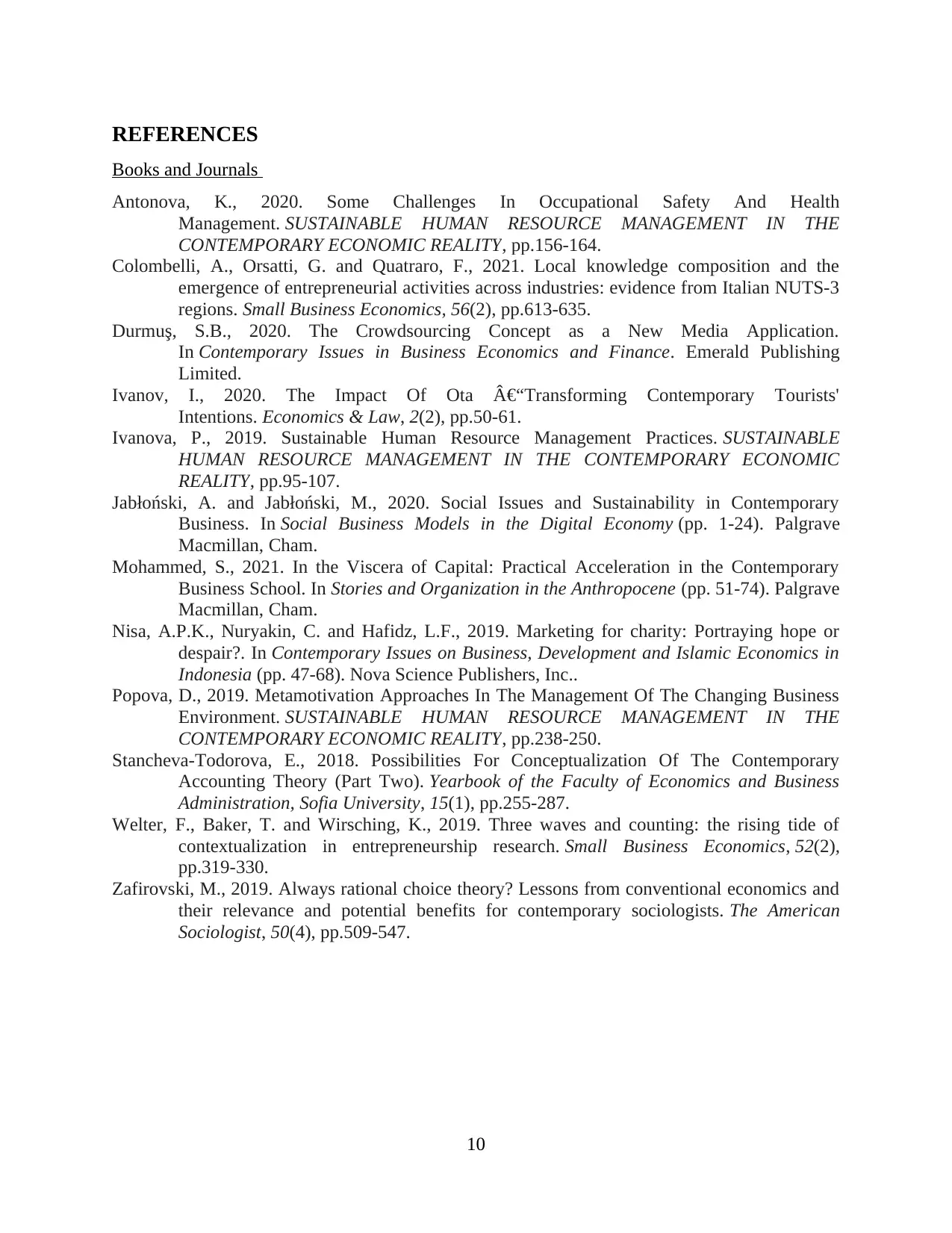
REFERENCES
Books and Journals
Antonova, K., 2020. Some Challenges In Occupational Safety And Health
Management. SUSTAINABLE HUMAN RESOURCE MANAGEMENT IN THE
CONTEMPORARY ECONOMIC REALITY, pp.156-164.
Colombelli, A., Orsatti, G. and Quatraro, F., 2021. Local knowledge composition and the
emergence of entrepreneurial activities across industries: evidence from Italian NUTS-3
regions. Small Business Economics, 56(2), pp.613-635.
Durmuş, S.B., 2020. The Crowdsourcing Concept as a New Media Application.
In Contemporary Issues in Business Economics and Finance. Emerald Publishing
Limited.
Ivanov, I., 2020. The Impact Of Ota €“Transforming Contemporary Tourists'
Intentions. Economics & Law, 2(2), pp.50-61.
Ivanova, P., 2019. Sustainable Human Resource Management Practices. SUSTAINABLE
HUMAN RESOURCE MANAGEMENT IN THE CONTEMPORARY ECONOMIC
REALITY, pp.95-107.
Jabłoński, A. and Jabłoński, M., 2020. Social Issues and Sustainability in Contemporary
Business. In Social Business Models in the Digital Economy (pp. 1-24). Palgrave
Macmillan, Cham.
Mohammed, S., 2021. In the Viscera of Capital: Practical Acceleration in the Contemporary
Business School. In Stories and Organization in the Anthropocene (pp. 51-74). Palgrave
Macmillan, Cham.
Nisa, A.P.K., Nuryakin, C. and Hafidz, L.F., 2019. Marketing for charity: Portraying hope or
despair?. In Contemporary Issues on Business, Development and Islamic Economics in
Indonesia (pp. 47-68). Nova Science Publishers, Inc..
Popova, D., 2019. Metamotivation Approaches In The Management Of The Changing Business
Environment. SUSTAINABLE HUMAN RESOURCE MANAGEMENT IN THE
CONTEMPORARY ECONOMIC REALITY, pp.238-250.
Stancheva-Todorova, E., 2018. Possibilities For Conceptualization Of The Contemporary
Accounting Theory (Part Two). Yearbook of the Faculty of Economics and Business
Administration, Sofia University, 15(1), pp.255-287.
Welter, F., Baker, T. and Wirsching, K., 2019. Three waves and counting: the rising tide of
contextualization in entrepreneurship research. Small Business Economics, 52(2),
pp.319-330.
Zafirovski, M., 2019. Always rational choice theory? Lessons from conventional economics and
their relevance and potential benefits for contemporary sociologists. The American
Sociologist, 50(4), pp.509-547.
10
Books and Journals
Antonova, K., 2020. Some Challenges In Occupational Safety And Health
Management. SUSTAINABLE HUMAN RESOURCE MANAGEMENT IN THE
CONTEMPORARY ECONOMIC REALITY, pp.156-164.
Colombelli, A., Orsatti, G. and Quatraro, F., 2021. Local knowledge composition and the
emergence of entrepreneurial activities across industries: evidence from Italian NUTS-3
regions. Small Business Economics, 56(2), pp.613-635.
Durmuş, S.B., 2020. The Crowdsourcing Concept as a New Media Application.
In Contemporary Issues in Business Economics and Finance. Emerald Publishing
Limited.
Ivanov, I., 2020. The Impact Of Ota €“Transforming Contemporary Tourists'
Intentions. Economics & Law, 2(2), pp.50-61.
Ivanova, P., 2019. Sustainable Human Resource Management Practices. SUSTAINABLE
HUMAN RESOURCE MANAGEMENT IN THE CONTEMPORARY ECONOMIC
REALITY, pp.95-107.
Jabłoński, A. and Jabłoński, M., 2020. Social Issues and Sustainability in Contemporary
Business. In Social Business Models in the Digital Economy (pp. 1-24). Palgrave
Macmillan, Cham.
Mohammed, S., 2021. In the Viscera of Capital: Practical Acceleration in the Contemporary
Business School. In Stories and Organization in the Anthropocene (pp. 51-74). Palgrave
Macmillan, Cham.
Nisa, A.P.K., Nuryakin, C. and Hafidz, L.F., 2019. Marketing for charity: Portraying hope or
despair?. In Contemporary Issues on Business, Development and Islamic Economics in
Indonesia (pp. 47-68). Nova Science Publishers, Inc..
Popova, D., 2019. Metamotivation Approaches In The Management Of The Changing Business
Environment. SUSTAINABLE HUMAN RESOURCE MANAGEMENT IN THE
CONTEMPORARY ECONOMIC REALITY, pp.238-250.
Stancheva-Todorova, E., 2018. Possibilities For Conceptualization Of The Contemporary
Accounting Theory (Part Two). Yearbook of the Faculty of Economics and Business
Administration, Sofia University, 15(1), pp.255-287.
Welter, F., Baker, T. and Wirsching, K., 2019. Three waves and counting: the rising tide of
contextualization in entrepreneurship research. Small Business Economics, 52(2),
pp.319-330.
Zafirovski, M., 2019. Always rational choice theory? Lessons from conventional economics and
their relevance and potential benefits for contemporary sociologists. The American
Sociologist, 50(4), pp.509-547.
10
1 out of 13
Related Documents
Your All-in-One AI-Powered Toolkit for Academic Success.
+13062052269
info@desklib.com
Available 24*7 on WhatsApp / Email
![[object Object]](/_next/static/media/star-bottom.7253800d.svg)
Unlock your academic potential
© 2024 | Zucol Services PVT LTD | All rights reserved.


